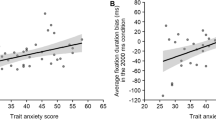Abstract
A CONJUGATE lateral eye movement has been observed in humans in association with the shift from external to internal direction of attention1. When asked a question requiring reflexion (for example, mental arithmetic) an individual normally shifts his eyes either to the right or the left as he begins to reflect on an answer. It has been suggested that the direction of this lateral eye movement is related to a characteristic deployment of attention; left movers show a greater tendency to focus attention on internal subjective experiences, right movers show a greater tendency to external focus of attention2. It has been found that subjects who tend to move their eyes to the left are more likely to be hypnotizable3. Hypnotizability has also been shown to be related to amount of EEG alpha activity during an eyes-closed resting condition4,5. The relationship of both lateral direction of eye movements and amount of EEG alpha activity to hypnotizability seems to indicate the need for a study of the relationship between amount of resting EEG alpha activity and the direction of reflective lateral eye movements. This study was designed to test the hypothesis that the tendency to move the eyes to the left is associated with more EEG alpha activity than is the tendency to move the eyes to the right.
This is a preview of subscription content, access via your institution
Access options
Subscribe to this journal
Receive 51 print issues and online access
$199.00 per year
only $3.90 per issue
Buy this article
- Purchase on Springer Link
- Instant access to full article PDF
Prices may be subject to local taxes which are calculated during checkout
Similar content being viewed by others
References
Day, M. E., Perceptual and Motor Skills, 19, 443 (1964).
Day, M. E., Psychotherapy, 5, 146 (1968).
Bakan, P., Perceptual and Motor Skills, 28, 927 (1969).
London, P., Hart, J. T., and Leibovitz, M. P., Nature, 219, 71 (1968).
Nowlis, D. P., and Rhead, J. C., Perceptual and Motor Skills, 27, 1047 (1968).
London, P., Hart, J. T., and Leibovitz, M. P., Nature, 219, 71 (1968); Mulholland, T. B., and Runnals, S., J. Psychol., 54, 69 (1962).
Nowlis, D. P., and Rhead, J. C., Perceptual and Motor Skills, 27, 1047 (1968).
Weitzenhofer, A. M., and Hilgard, E. R., Stanford Hypnotic Susceptibility Scale, Form C (Consulting Psychologists Press, Palo Alto, 1962).
Day, M. E., J. Psychol., 66, 51 (1967).
Author information
Authors and Affiliations
Rights and permissions
About this article
Cite this article
BAKAN, P., SVORAD, D. Resting EEG Alpha and Asymmetry of Reflective Lateral Eye Movements. Nature 223, 975–976 (1969). https://doi.org/10.1038/223975a0
Received:
Issue Date:
DOI: https://doi.org/10.1038/223975a0
This article is cited by
-
Group based Swarm evolution algorithm (GSEA) driven mental task classifier
Memetic Computing (2015)
-
Hypnosis modelling in neural networks
Bulletin of Mathematical Biology (1995)
Comments
By submitting a comment you agree to abide by our Terms and Community Guidelines. If you find something abusive or that does not comply with our terms or guidelines please flag it as inappropriate.



